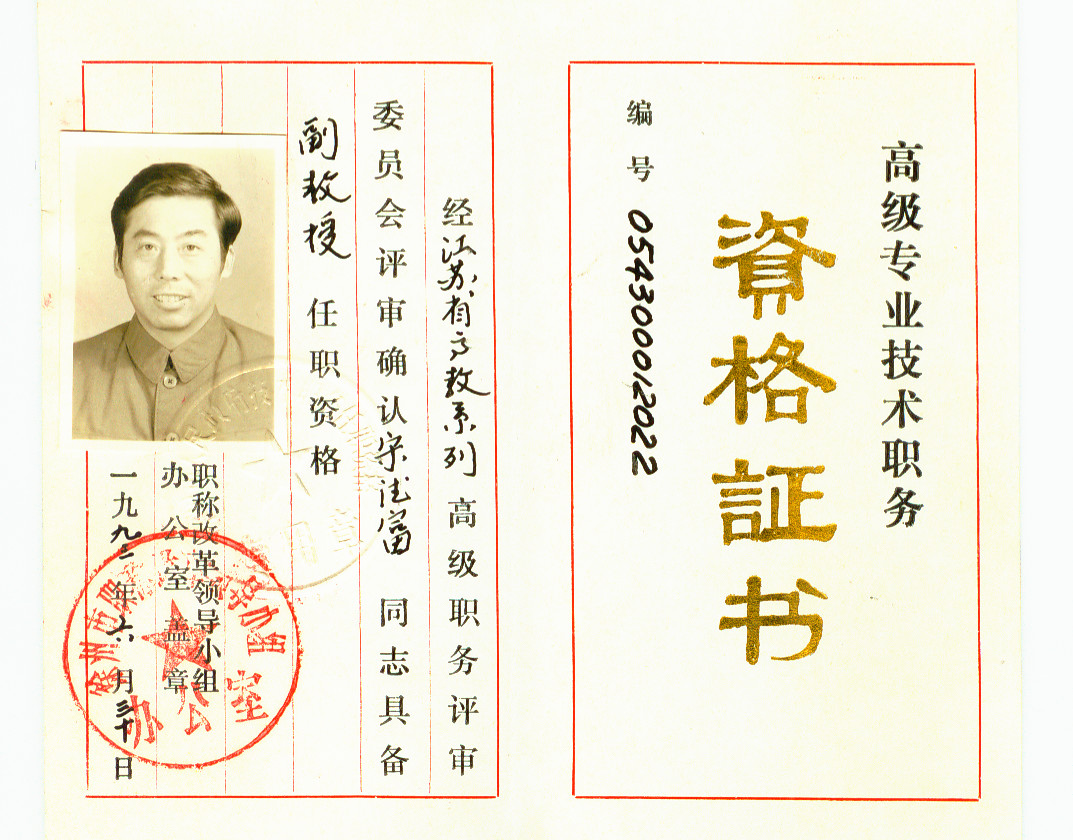I was introduced into Pengda as a middle school senior teacher and enjoyed the treatment of an associate professor. At that time, there were very few associate professors, rare personnel. Once on an art performance, a program called “professor chorus” appeared on the stage, altogether less than a dozen people, among whom I was the youngest. Many teachers older than me remained the academic title of lecturer or engineer. I began to be concerned with the problem how I could change my title and turn it into an associate professor. I felt uncomfortable to be a middle school senior teacher, the inappropriate title could not last forever. The personnel department told me that I must be of enough college teaching age and appear some teaching or academic theses, which meant that my articles published in the middle school were of no use. I had no choice but concentrate my efforts on writing theses and publish them as soon as possible so that I could apply for the title of an associate professor when I had enough college age.
Meilan Zhang had a middle school classmate, named Taihong Zhang, who held the position of the chief librarian in Xuzhou Normal University and was familiar with the chief editor of the university journal. Taihong Zhang was a warmhearted man and willing to recommend my article to the editor. What kind of thesis could I write, which could display the quality of the recommender. I was determined that my article would be sure not to occupy a piece of position without real qualification. I felt shameful if my article was not qualified and pressed the editor to publish it. After days’ thinking I decided to proceed from Quirk’s Comprehensive Grammar of the English Language.
Because I had read the two grammar books by Quirk, I could compare them and discover the authors’ research train of thought. Adverbial elements are not the necessary parts of sentence structures, but they have range of semantic roles and realization forms, and can be of multiple occurrences in the same clause. Their positions are flexible and grammatical functions are distinctive. As a result the classification of adverbial elements is a hard job. Usually we classify the adverbials according to their semantic roles, for example, the adverbial of space, time, process, degree, condition and etc. In their first grammar book “A Grammar of Contemporary English” (GCE), the co-authors divided the adverbial elements into two parts, according to whether they had the same properties as the basic elements of the sentence or not. If they had, they were named “adjunct” and if they did not have, they were re-divided into two, one called conjunct because they had the conjunct function and the other which had no conjunct function called disjunct. But in their second book “A Comprehensive Grammar of the English Language”(CGE), they divided the adjunct also into two parts, the central part called “adjunct”, and the peripheral part “subjunct”.
The scientific research needs the classification, but it is not an easy job. Be sure to remember that there is no remarkable distinction between the classes. The artificial division is compulsive and cannot be precise. Accordingly the fuzzy logic came into being, which holds the view that there is fuzzy part between classes. Simple examples: What degree means hot weather and what degree means warm weather. Precisely, which degree is the cut-off point? Similarly, what kind of man is a tall man and what kind of man is of medium-height? What centimeter height is the cut-off point? The difference between a male and female seems remarkable, but what about the hermaphrodite? It is not strange that the International Olympic Committee found it necessary to define what is masculine or femininity. The city traffic management of Melbourne, Australia, divided the whole city into two or three zones, using the city centre as the centre of a circle and drawing two or three concentric circles, named Zone 1, Zone 2 and Zone 3, so that traffic price can be decided within or beyond a zone or two or three zones across, and managed by computers. The designers of the management do know the fuzzy logic and define the stations on and close to the perimeter as fuzzy zones, which means that these stations belong to two zones, both Zone 1 and Zone 2, or both Zone 2 and Zone 3, so that the price is more reasonable and riders or commuters get the psychological balance. The income taxes of every country should be classified. If the policy maker knows the fuzzy logic, they should let a fuzzy zone exist, avoiding such a case that one dollar income plus might make you pay much more money for the tax.
Quirk and his co-authors did know the complex of the classification and used a lot of model sentences to expound the fuzzy zone between the noun and the verb. However they did not use the term “fuzzy logic” and used “gradient” instead. The new classification of the adverbials must also deal with the fuzzy or gradient problem. For example, the viewpoint adverbials (architecturally, morally, politically, technically etc.) were first defined as the central part of the adjunct, i.e. they had all the nature of the basic elements of the sentence, but later renamed as viewpoint subjuncts, i.e. they didn’t have all the nature of the basic elements of the sentence. I wrote a letter to Quirk and tried to make him embarrassed, using the nature of the basic elements of a sentence to test the viewpoint adverbs, to see whether the result sentences acceptable or not. Quirk replied to me, “It would in fact be difficult to reject as totally (incomprehensible) any of your test versions 1-5, but difficult also to give them a confident ‘green light’. In some ways viewpoint adverbials are more like disjuncts than the set of subjuncts. Discussion continues among the co-authorship of how best to analyze them.” So I concluded that the classification of the adverbials by Quirk and his co-authors waited for further improvements and the fuzzy logic should be utilized in order that convincing analysis can be achieved.
According to the content mentioned above, I thought and thought for more than a month, forming a long thesis and handing in to the chief editor of the journal of Xuzhou Normal University, Mian Zhou, who made an appointment with me in Taihong Zhang’s home a few days later. He went over the article and held the view that it had some degree of depth and could be published on the journal.
That was the first time for me to ask an acquaintance to help publish an article, which I felt was unfit for my personality. I continued to read Quirk and when I came upon puzzles I wrote letters directly to him, exchanging views with him. Finally I composed another new long thesis and made a spurt toward the journals of the key foreign language universities.
The key foreign language study universities include first Beijing and Shanghai in the next place. It was very difficult to publish a long thesis on the journals of the key universities without the recommendation by an acquaintance. I discovered not one flaw but several flaws when I was reading Quirk. The ancient Chinese saying is reasonable that no man is wise at all times and the greatest fool, in a thousand schemes, must hit once on the truth. Quirk was a world-famous scholar and familiar to every English learner in China if he or she reached a certain level. This wise man made some flaws in his large book, which I had detected. By thinking repeatedly, I became more and more confident and decided to present a challenge to him, using the method of the compelling reason, in order to conquer the editor and convince the readers.
The first issue I wanted to address was a somewhat popular one, namely the sentence pattern N1+V+N2+toV+N3. Almost all the grammar books and the teaching materials considered the following 3 sentences to be the basic structure of S(ubject) + V(erb) + O(bject) + (Object) C(omplement).
N1 | V | N2 | to V | N3 | |
(1) | We | like | all parents | to visit | the school. |
(2) | They | expected | James | to win | the race. |
(3) | Mr. Tate | is teaching | his boy | to read | a poet. |
Quirk held the view that the three sentences had superficially similar but basically different constructions. Please see the different constructions of the three sentences below.
N1 | V | N2 toV N3 | ||
(1) | S(subject) We | V(verb) like | O(object) | |
all parents to visit the school. | ||||
(2) | S They | V expected | O James | Co(O complement) to win the race. |
(3) | S Mr. Tate | V is teaching | Oi(Indirect O) his boy | Od(Direct O) to read a poet. |
Quirk and his co-authors analysed them respectively as (1) monotransitive (SVO), (2) complex transitive (SVOCo) and (3) ditransitive (SVOiOd). Sentence (1) was considered as SVO instead of SVOCo because verbs, such as like, love, hate, can’t bear etc. may be followed by to infinitive and v–ing form as well. When they are followed by an –ing form, there can be a logical subject before it. When the logical subject is a pronoun, it can be its object form. Despite of the object form we cannot say that the logic subject of the v–ing is the object of the main verb of the sentence. For example, in the sentence “The child couldn’t bear me being away so long.” we can use to infinitive to replace the v–ing form, “me” in front of the to-infinitive cannot be regarded as the object of the main verb “couldn’t bear”, but as the logical subject of the to-infinitive: “The child couldn’t bear me to be away so long.” Semantically, Sentence (1) expressed what we like is that all parents visit the school, not all parents.
Why Quirk considered Sentence (3) as ditransitive has several reasons, the most reasonable one is that we can use “what” to question the part of toV + N3, namely, ---What is Mr. Tate teaching his boy? ---He is teaching him to read a poet.
Unfortunately, Quirk and his co-authors made a mistake, using the verb “ask”, instead of “teach”:
They asked the children to bring some food.
In the sentence above the main verb “ask” means “order”, “direct” and cannot be ditransitive. Only when “ask” means “request” can it be ditransitive. Due to their ignorance that different meanings of a verb can be followed by a different sentence structure, they mistakenly classified the following complex transitive verbs as ditransitve verbs:
I told/advised/persuade Mark to see a doctor.
I summarized the verbs which can form the different structures of N1 + V + N2 + toV + N3 sentence pattern:
1. The verbs which can be followed by the to-infinitive with logical subject are not many. Semantically, they indicate like or dislike, want or not want. They are: can’t bear, desire, hate, like, love, prefer, want, wish and etc.
2. There are many complex transitive verbs followed by to-infinitive as their object complements, which can be divided into two groups. The first group must be followed by a stative to-infinitive as its object complement, mainly to be infinitive, perfect infinitive and progressive infinitive. The typical verbs are: report, assume, believe, consider, find and etc. The second group has the meaning of “order and request”, the meaning of “intention”, the meaning of “causing” and the meaning of “allowance” and “forbiddance”. They are: order, ask, tell, require, direct, intend, mean, cause, drive, lead, get, allow, enable, oblige, permit and etc.
3. The ditransitive verbs which can be followed by to-infinitve as their indirect object are not many. The main characteristics is that toV can be performed either by N2, or by N1 and even by both N2 and N1. For example, “He promised me to take the medicine for cough.” The verb “take” in it is performed by N1, instead of N2. On the contrary, in sentence (1), N2 is the logical subject of toV instead of the object of the main verb; in the complex transitive sentence 2, N2 is the object of the main verb and the subject of the toV as well.
Thinking is just like ten months' pregnancy and writing a thesis like giving birth to a child. It took me nearly one year to think, rethink and arrange and rearrange,but I spent only 2 to 3 days forming a long thesis. Mailing it to the editor of the journal of Shanghai Foreign Language Study University, I received a reply in not very long time. The letter said that the thesis was approved by three checkups, which made me very stimulated. I exclaimed: April showers bring May flowers. The journal “Foreign Language” of Shanghai Foreign Language Study University is a bimonthly one, 19cm X 26cm, and my thesis occupied the whole 7 pages. At the end of the thesis I had written the process of how to form it. Now I wrote it down for a souvenir.
This article was one year in gestation. When I began to read Chapter 16 of CGE, I was subdued by Quirk, who had given a brilliant exposition of the sentence pattern N1 + V + N2 + toV + N3. I followed the authors’ train of thought and began the process of my own understanding and digesting what I had read. But we began to throw doubt on what was said about the ditransitive verbs which required to-infinitive as indirect object. We braced myself and read the relative chapter again and again, forcing myself to think according to the authors’ train of thought. However we failed to grasp the main points although we thought and thought again and again. My train of thought was disturbed, I could not fall asleep and had a poor appetite, having no choice but lay it aside. After a period of time, I picked up the subject and made a survey of all the ditransitive verbs which could use to-infinitive as their indirect object. In the end I discovered where the problem lay. Obstacles were surmounted, the lock gate of the train of my thought was open and I began to write very quickly. Finally I completed the thesis without stopping, very much like “ten months' pregnancy and giving birth to a child in a day”. Whether the standpoint of this thesis could stand firm is to be verified by the readers. Any commentary is welcome and I expect the authors of the CGE to accept my analysis. My unique desire is to contribute a little to the improvement of the new grammatical system in order to speed up its popularity.
When I was writing the two large theses mentioned above, I also wrote short articles, several of which had been published. See the following table:
Time | Magazine | Title of the Article | Universities |
1991/09 | Scientific English Learning | Stress patterns of vocabularies with multiple syllables | Shanghai Jiaotong University |
1991/10 | Teaching Yourself English | “Of” between adjective and noun(or pronoun) | Shanghai Foreign Language Study University |
1992/04 | English Knowledge | Approximately, About, Around, Roughly | Dalian Foreign Language Institute |
1992/04 | FLTS | Semantic meanings of phrasal verbs | Beijing Normal University |
1992/07 | Scientific English Learning | English Words Expressing the meaning of “Base” | Shanghai Jiaotong University |
1992/08 | English Learning | synonym discrimination of words expressing “vocation” | Beijing Foreign Language Study University |
In March of 1993, I applied for transforming my title of a middle school senior teacher into the title of an associate professor. I believed conditions were ripe and success would come. I had now enough college teaching age and published so many theses within less than 3 years. It was unnecessary to find some authorized one to help me. As I expected, I acquire the qualified title of an associate professor approved by the provincial high-rank judge committee.

qualificaiton cetificate of associate professor
On the contrary, there were a few teachers who, older than me, were not approved as an associate professor. Their pained expressions could not be hidden. Some introduced engineers and researchers applied for high rank engineers and researchers instead of associate professors because these two series of high-rank judge committee approved the high-rank title much more easily.
April 2 of 2010 in Xuzhou
Proofreading on Feb. 24, 2012 in Chicago
Uploading on Aug. 6, 2023 in Xuzhou









